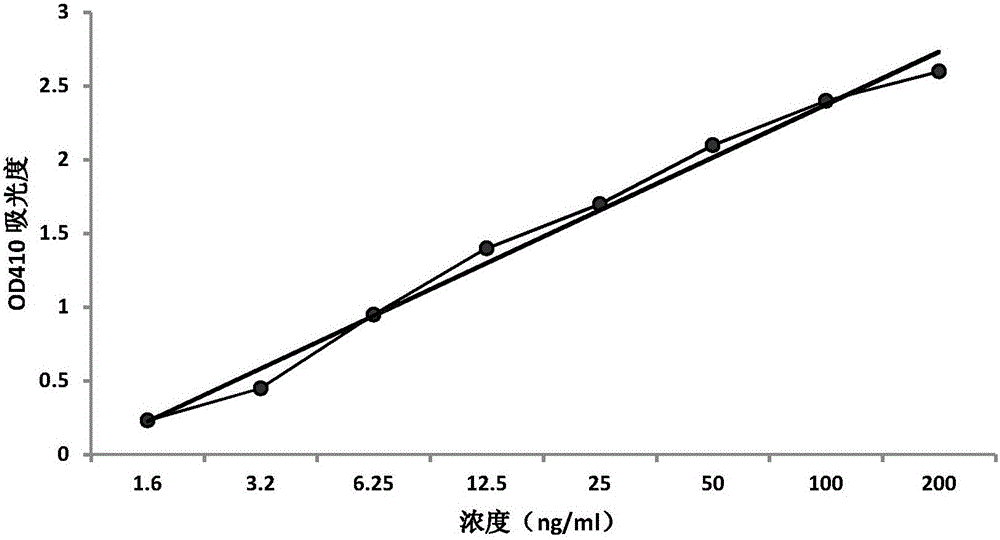A method for screening monoclonal antibodies with different antigen binding sites
A monoclonal antibody and binding site technology, applied in the biological field, can solve problems such as a lot of workload and time, and achieve the effect of shortening time and simplifying screening steps.
- Summary
- Abstract
- Description
- Claims
- Application Information
AI Technical Summary
Problems solved by technology
Method used
Image
Examples
example 1
[0025] Example 1 Preparation of ST2 Single Clone Antibody Hybrid Tumor Cell
[0026] Mix the complete blessing agent and human ST2 solution as a proportion of 1: 1 to make emulsions.Multi-point injection of immune to 6-8 weeks of age female Balb / C mice (200 micro rises per mouse, about 40 micro rising per point).Two weeks later, a lotion was mixed with an incomplete prefecture agent and human ST2 solution at a ratio of 1: 1.After two weeks, the blood measurement of the antibody was measured.After the end vein injection, the ST2 of the immune mice was strengthened. Four days later, the mice were executed, spleen cells were separated, and the separated spleen cells were merged with the mouse myeloma cell SP2 / 0 cells with 50% PEG.Then choose to train at the medium containing HAT.Only fusion cells can survive in the HAT medium.
Embodiment 2
[0027] Example 2 Anti -person ST2 monoclonal antibody hybrid tumor cell screening
[0028] The ST2 solution with a ST2 solution of 100 micro -ascending in the PBS buffer concentration is 1 micrograms per milliliter, respectively, and placed 4 degrees for one night at 4 degrees.The next day, washed the 96 -hole enzyme standard plate of the ST2 package (PBS buffer containing 0.05% TWEEN) twice.Then use a closed solution (1%BSA / washing liquid) room temperature to close the enzyme standard plate for two hours.Pour the closed liquid, then add 100 microcytopenia cells to 96 pores obtained by the hybrid tumor culture liquid obtained by the Example 1, and the room temperature is incubated for 2 hours.0.05% TWEEN PBS buffer) washing the board twice, and then added 100 microline alkalinase marked sheep antibody IgG antibodies to add 96 -hole enzyme standard plates, room temperature for 1 hour, washed with a lotion with a lotionSecond, add 100 micro-lift color reaction substrates (4-nitrate ...
Embodiment 3
[0029] Example 3 Hybrid Tumor Cell Cultivation Cultivation
[0030] Single cloned hybrid tumor cells can be cultivated by limited dilution method.The specific method is as follows. The hybrid tumor cell counting of the positive anti -human ST2 antibody obtained by the Example 2 is a single -cell suspension with a series of cells / 200 micro -rising single cells.Add 200 microcytes of single -cell suspension to a small hole (1 cell / 0.2ml / hole) of the 96 -hole cell culture plate.At 37 degrees, 5%carbon dioxide cell culture box culture.Choose a monoclonal hole for about 10 days to detect antibodies, such as positive, and then cloned. Generally, cloning 3 times.Choose a cloning of strong antibody positive and cellular growth, expand the cultivation, build, and save.
PUM
 Login to View More
Login to View More Abstract
Description
Claims
Application Information
 Login to View More
Login to View More - R&D
- Intellectual Property
- Life Sciences
- Materials
- Tech Scout
- Unparalleled Data Quality
- Higher Quality Content
- 60% Fewer Hallucinations
Browse by: Latest US Patents, China's latest patents, Technical Efficacy Thesaurus, Application Domain, Technology Topic, Popular Technical Reports.
© 2025 PatSnap. All rights reserved.Legal|Privacy policy|Modern Slavery Act Transparency Statement|Sitemap|About US| Contact US: help@patsnap.com

